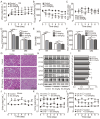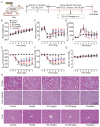Druggability Studies of Benzene Sulfonamide Substituted Diarylamide (E3) as a Novel Diuretic
- PMID: 40299675
- PMCID: PMC12024912
- DOI: 10.3390/biomedicines13040992
Druggability Studies of Benzene Sulfonamide Substituted Diarylamide (E3) as a Novel Diuretic
Abstract
Background/Objectives: Urea transporters (UTs) play an important role in the urine-concentrating mechanism and have been regarded as a novel drug target for developing salt-sparing diuretics. Our previous studies found that diarylamides 1H and 25a are specific UT inhibitors and have oral diuretic activity. However, these compounds necessitate further optimization and comprehensive druggability studies. Methods: The optimal compound was identified through structural optimization. Experiments were conducted to investigate its UT inhibitory activity and evaluate its diuretic effect. Furthermore, disease models were utilized to assess the compound's efficacy in treating hyponatremia. Pharmacokinetic studies were performed to examine its metabolic stability, and toxicity tests were conducted to evaluate its safety. Results: Based on the chemical structure of compound 25a, we synthesized a novel diarylamide compound, E3, by introducing a benzenesulfonamide group into its side chain. E3 exhibited dose-dependent inhibition of UT at the nanomolar level and demonstrated oral diuretic activity without causing electrolyte excretion disorders in both mice and rats. Experiments on UT-B-/- and UT-A1-/- mice indicated that E3 enhances the diuretic effect primarily by inhibiting UT-A1 more effectively than UT-B. Furthermore, E3 displayed good metabolic stability and favorable pharmacokinetic characteristics. E3 significantly ameliorated hyponatremia through diuresis in a rat model. Importantly, E3 did not induce acute oral toxicity, subacute oral toxicity, genotoxicity, or cardiotoxicity. Conclusions: Our study confirms that E3 exerts a diuretic effect by specifically inhibiting UTs and has good druggability, which offers potential for E3 to be developed into a new diuretic for the treatment of hyponatremia.
Keywords: diuretic; hyponatremia; pharmacokinetic; safety evaluation; structure optimization; urea transporter inhibitor.
Conflict of interest statement
The authors Jing Li and Yinglin Zuo were employed by the company Sunshine Lake Pharma Co., Ltd. The remaining authors declare that the research was conducted in the absence of any commercial or financial relationships that could be construed as a potential conflict of interest.
Figures







Similar articles
-
N-(4-acetamidophenyl)-5-acetylfuran-2-carboxamide as a novel orally available diuretic that targets urea transporters with improved PD and PK properties.Eur J Med Chem. 2021 Dec 15;226:113859. doi: 10.1016/j.ejmech.2021.113859. Epub 2021 Sep 24. Eur J Med Chem. 2021. PMID: 34601246
-
Discovery of novel diarylamides as orally active diuretics targeting urea transporters.Acta Pharm Sin B. 2021 Jan;11(1):181-202. doi: 10.1016/j.apsb.2020.06.001. Epub 2020 Jun 14. Acta Pharm Sin B. 2021. PMID: 33532188 Free PMC article.
-
Urea transporter UT-A1 as a novel drug target for hyponatremia.FASEB J. 2024 Jul 15;38(13):e23760. doi: 10.1096/fj.202400555RR. FASEB J. 2024. PMID: 38924449
-
Urea Transporters Identified as Novel Diuretic Drug Targets.Curr Drug Targets. 2020;21(3):279-287. doi: 10.2174/1389450120666191129101915. Curr Drug Targets. 2020. PMID: 31782365 Review.
-
Urea transporter proteins as targets for small-molecule diuretics.Nat Rev Nephrol. 2015 Feb;11(2):113-23. doi: 10.1038/nrneph.2014.219. Epub 2014 Dec 9. Nat Rev Nephrol. 2015. PMID: 25488859 Free PMC article. Review.
Cited by
-
Structural characterization of the urea transporter bound to the orally bioavailable inhibitor E3.Acta Pharmacol Sin. 2025 Jun 16. doi: 10.1038/s41401-025-01595-7. Online ahead of print. Acta Pharmacol Sin. 2025. PMID: 40523902
References
-
- Inker L.A., Grams M.E., Levey A.S., Coresh J., Cirillo M., Collins J.F., Gansevoort R.T., Gutierrez O.M., Hamano T., Heine G.H., et al. Relationship of Estimated GFR and Albuminuria to Concurrent Laboratory Abnormalities: An Individual Participant Data Meta-analysis in a Global Consortium. Am. J. Kidney Dis. 2019;73:206–217. doi: 10.1053/j.ajkd.2018.08.013. - DOI - PMC - PubMed
-
- Chatur S., Vaduganathan M., Claggett B., Vardeny O., Desai A.S., Jhund P.S., de Boer R.A., Lam C.S.P., Kosiborod M.N., Shah S.J., et al. Dapagliflozin and diuretic utilization in heart failure with mildly reduced or preserved ejection fraction: The DELIVER trial. Eur. Heart J. 2023;44:2930–2943. doi: 10.1093/eurheartj/ehad283. - DOI - PMC - PubMed
Grants and funding
LinkOut - more resources
Full Text Sources

